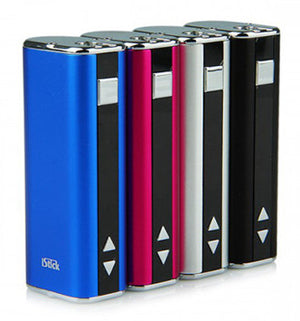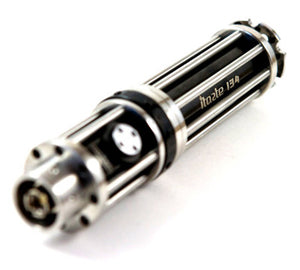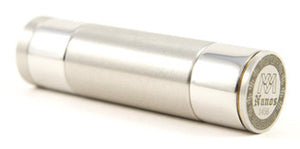MODs and Advanced Personal Vaporizers (APVs) - Tips and Help
Everything You Need To Know About MODs and Advanced Personal Vaporizers (APVs)
With such a huge array of electronic cigarette and vaping devices on the market today, it seems impossible to decipher what each product actually is, and what its functions are. However, no category of products seems to confuse individuals more than MODs and APVs. What exactly are they? What is the difference between them? What do they stand for? Virtually every electronic cigarette and vapor website categorizes these devices differently, thereby adding to the confusion. This article will attempt to clarify this puzzling topic.

To begin, let us first clarify what each acronym stands for. An APV is short for Advanced Personal Vaporizer. MOD stands for Modified or Modification. The first fundamental fact to understand is that MODs and APVs are synonymous with one another. In other words, they are two words that describe the same thing. (This does not include mechanical MODs, which we will get into later).
Now that we have a basic understanding of the terminology, it would be helpful to next briefly look at the history of MODs and APVs. The first commercially available rechargeable electronic cigarettes were designed to mimic the look and feel of real cigarettes. One of the major problems that existed with the first e-cigarettes was the poor battery life. They quickly died, and had to be recharged after just an hour or two of use. As the popularity of electronic cigarettes grew, so did the wants, needs, and ultimately, the demands of its users. Batteries that needed a recharge after a couple hours was simply unacceptable.
Innovative individuals saw the need for longer-lasting electronic cigarettes, so they began modifying existing devices to hold larger, lithium-ion batteries rather than smaller, alkaline batteries. They would generally use casings, such as a flashlight body, which would be able to hold large lithium-ion batteries. They called their contraptions MODs—short for modified. That name has stuck ever since, and is now a generic term used to describe larger vaporizers, such as the Joyetech eVic or SMOKtech S.I.D. However, since the big manufacturers have begun dominating the market by producing their own devices, they have simultaneously coined a new word for these new high-tech vaporizers: Advanced Personal Vaporizers or APVs. This modification of verbiage is to more clearly and accurately describe what the device actually is.
What Is An Advanced Personal Vaporizer?
Advanced Personal Vaporizers function in essentially the same way as traditional electronic cigarettes, with two primary differences: Larger battery capacity and replaceable internal batteries. Recent variations now include advanced operations, such as the ability to digitally adjust the voltage and wattage, the ability to connect it to your computer for graphic visualizations of your vaping history, and operating systems, to name a few.

The are two primary styles of APVs: Box Mods (such as the Eleaf iStick) and Tube Mods (such as the Innokin iTaste SVD 2). The names of these two styles are suitable to them, as they accurately describe their respective shapes. That is, Box Mods are square or rectangular in shape, while Tube Mods are cylindrical in shape. Within these two basic styles, there are three types of available voltage regulation: Regulated, Unregulated, and Variable Voltage. Regulated APVs contain an onboard circuit board that regulates the battery to provide a constant fixed voltage throughout the course of the battery life. That is, the voltage output doesn’t decrease as the battery life depletes. Unregulated devices, on the other hand, do not contain circuit boards, so the voltage output will decrease as the battery life diminishes. Variable voltage APVs, however, allow the user to manually adjust the voltage output based on the clearomizer or cartomizer being used. This affords the user the opportunity to use virtually any clearomizer or cartomizer that he/she desires.
There are also variable wattage options available on many APV devices. Variable wattage APVs work similarly to variable voltage, however, rather than the user manually adjusting the output based on the clearomizer or cartomizer being used, the device itself actually detects and measures the resistance of it, and automatically adjusts the voltage for optimal performance.
What Are Mechanical MODs?
 Unlike traditional MODs or APVs, which have onboard circuitry, wiring, chips, screens, etc., mechanical MODs do not contain electronics or circuitry of any kind. A mechanical MOD is simply a casing that holds the battery, and a manual button that then connects to an atomizer of some sort. The button doesn’t send a signal to the battery releasing power to the atomizer. Rather, the battery simply completes the connection between the battery and the atomizer, thereby vaporizing the liquid. The advantages of mechanical MODs includes the ability of the device to get wet without damaging it, and reduced likelihood of malfunction due to its lack of circuitry.
Unlike traditional MODs or APVs, which have onboard circuitry, wiring, chips, screens, etc., mechanical MODs do not contain electronics or circuitry of any kind. A mechanical MOD is simply a casing that holds the battery, and a manual button that then connects to an atomizer of some sort. The button doesn’t send a signal to the battery releasing power to the atomizer. Rather, the battery simply completes the connection between the battery and the atomizer, thereby vaporizing the liquid. The advantages of mechanical MODs includes the ability of the device to get wet without damaging it, and reduced likelihood of malfunction due to its lack of circuitry.
How Safe Are MODs/APVs?
MODs themselves are generally very safe, as they are nothing more than a housing unit for the batteries. The critical element with respect to the safety of MODs/APVs is the lithium-ion battery being used. Firstly, it is critical that you are using the appropriate battery for your device. The manufacturer will describe what the proper battery is. Second, it is very much advisable to use high-quality batteries developed by well-known brands, such as Sony or Panasonic. Lastly, it is crucial to use the correct charger for the battery. With these precautions taken, MODs and APVs are very safe to use, and are loaded with a host of benefits.










